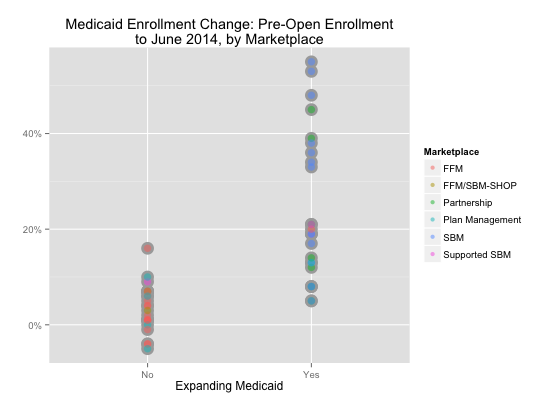Not surprisingly, Medicaid enrollment is up in states where they want Medicaid.
Since open enrollment for expanded Medicaid coverage started last October under Obamacare the Affordable Care Act, the federal government has been releasing Medicaid enrollment numbers for all 50 states. In the most recent report released August 8, Medicaid enrollment is up in the states that have decided to expand (25 + DC), while in states that didn’t expand Medicaid, enrollment is do- Wait, enrollment is actually up in most of those states, too.
For instance, in Kentucky, an expansion state, Medicaid enrollment is up almost 17% from this time last year. Neighboring Tennessee, which hasn’t expanded, is still up 7%. The word is out on enrolling for health insurance, whether it’s for private plans or Medicaid.
From May to June 2014, six months into expansion, Medicaid enrollment increased nearly everywhere.

Even states not expanding Medicaid are seeing their Medicaid rolls grow from month-to-month. (Source: CMS)
Taking a wider view, CMS tracks the enrollment change from before open enrollment (the average of June through September 2013) to June 2014. In expanding states, there has been an 18% increase since last year (6.5 million more people), while non-expanding states have increase 4% (975,000 people). You can see the stark difference in the chart below:

There is a stark difference in Medicaid enrollment between non-expanding states and expanding states. (Source: CMS)
Each dot is a state, and the brighter the dot, the more states are clustered around that percentage. For expanding states, Nevada and Oregon have increased their Medicaid population by over 50%, while the highest non-expanding state is Georgia, by percentage (16%) and population (246,000 more people). You’d think with that much pent up demand in places like Georgia or Florida (223,000 more people), that would move the needle a bit in the state legislatures.
Taking a more detailed dive into the year-to-year change, below shows the type of online health care exchange states are using. The exchange can be both for Medicaid and private insurance.

States that are expanding Medicaid are less likely to leave managing their health care exchange to solely the federal government. (Source: CMS)
As you’d expect, the states expanding Medicaid are more likely to be running their own exchange (SBM) or partner with the federal government (Partnership). Non-expanding states usually leave it to the feds to run on their own, or only have a small part of it run by the state. (For example, Mississippi has an exchange for small business health plans that they run.)
These monthly enrollment reports really demonstrate how the politics of the Affordable Care Act through the lens of Medicaid expansion is creating vastly different health care environments for the working poor.
(Code for the plots is on GitHub here.)
